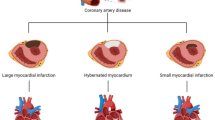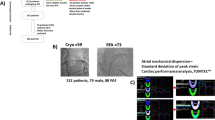Abstract
Background
Adequate synchronization between the passive (“E”) and active (“a”) left ventricular (LV) diastolic filling contributes to the efficiency of the heartbeat. E/a superposition in dual-chamber pacemaker (PM) recipients is an under-recognized phenomenon that may be corrected by shortening the atrio-ventricular interval (AVI). We aimed at establishing the prevalence of E/a superposition in PM patients and to analyze the clinical, echocardiographic, and biological impact of AVI shortening.
Methods
Seventy patients with dual-chamber PMs (74 ± 8 years old, 12 women) were consecutively enrolled in this study. Patients with baseline E/a superposition were crossed over from default to manually shortened AVI or vice versa in a case–control fashion (intervention group). Patients without baseline E/a superposition (controls) served as a reference for a descriptive comparison with the intervention group.
Results
Thirty-three patients had E/a superposition after PM implantation (47%). Controls (n = 37) had higher LV ejection fraction (59 ± 8% vs. 53 ± 10%, p = 0.048) and lower levels of high sensitive troponin T and ST2 (p < 0.05) than intervention group patients. The AVI was shortened at 48 ± 9 ms in order to ensure adequate E/a separation. The walked distance increased from 75 ± 17 to 78 ± 10% (p = 0.049) and the Euro-QoL score from 0.50 ± 0.27 to 0.63 ± 0.19 (p = 0.011) with short AVI.
Conclusions
E/a superposition occurs in approximately half of dual-chamber PM recipients and is associated with reduced LV function and increased myocardial injury biomarkers. AVI shortening produces a modest but significant effect in functional capacity and quality of life.



Similar content being viewed by others
References
Nagueh SF, Smiseth OA, Appleton CP, Byrd BF 3rd, Dokainish H, Edvardsen T, Flachskampf FA, Gillebert TC, Klein AL, Lancellotti P, Marino P, Oh JK, Popescu BA, Waggoner AD. Recommendations for the evaluation of left ventricular diastolic function by echocardiography: an update from the American Society of Echocardiography and the European Association of Cardiovascular Imaging. Eur Heart J Cardiovasc Imaging. 2016;17:1321–60.
Auricchio A, Sommariva L, Salo RW, Scafuri A, Chiariello L. Improvement of cardiac function in patients with severe congestive heart failure and coronary artery disease by dual chamber pacing with shortened AV delay. PACE. 1993;16:2034–43.
Occhetta E, Piccinino C, Francalacci G, Magnani A, Bolognese L, Devecchi P, Rognoni G, Rossi P. Lack of influence of atrioventricular delay on stroke volume at rest in patients with complete atrioventricular block and dual chamber pacing. Pacing Clin Electrophysiol. 1990;13:916–26.
Ishikawa T, Sumita S, Kimura K, Kikuchi M, Kosuge M, Kuji N, Endo T, Sugano T, Sigemasa T, Kobayashi I, Tochikubo O, Usui T. Prediction of optimal atrioventricular delay in patients with implanted DDD pacemakers. PACE. 1990;22:1365–71.
Rossi R, Muia M Jr, Turco V, Sgura FA, Molinari R, Modena MG. Short atrioventricular delay reduces the degree of mitral regurgitation in patients with a sequential dual-chamber pacemaker. Am J Cardiol. 1997;80:901–5.
Whinnett ZI, Afzal Sohaib SM, Mason M, Duncan E, Tanner M, Lefroy D, Al-Obaidi M, Ellery S, Leyva-Leon F, Betts T, Dayer M, Foley P, Swinburn J, Thomas M, Khiani R, Wong T, Yousef Z, Rogers D, Kalra PR, Dhileepan V, March R, Howard J, Kyriacou A, Mayet J, Kanagaratnam P, Frenneaux M, Hughes AD, Francis DP. Multicenter randomized controlled crossover trial comparing hemodynamic optimization against echocardiographic optimization of AV and VV delay of cardiac resynchronization therapy: The BRAVO Trial. JACC Cardiovasc Imaging. 2019;12:1407–16.
Varma N, Hu Y, Connolly AT, Thibault B, Singh B, Mont L, Nabutovsky Y, Zareba W. Gain in real-world cardiac resynchronization therapy efficacy with SyncAV dynamic optimization: Heart failure hospitalizations and costs. Heart Rhythm. 2021;18:1577–85.
ATS Committee on Proficiency Standards for Clinical Pulmonary Function Laboratories. ATS statement: guidelines for the six-minute walk test. Am J Respir Crit Care Med. 2002;166:111–7.
EuroQol group. EuroQol: a new facility for the measurement of health-related quality of life. Health Policy. 1990;16:199–208.
Bayés-Genís A, Núñez J, Lupón J. Soluble ST2 for prognosis and monitoring in heart failure: the new gold standard? J Am Coll Cardiol. 2017;70:2389–92.
Bayes-Genis A, Barallat J, Galán A, de Antonio M, Domingo M, Zamora E, Gastelurrutia P, Vila J, Peñafiel J, Gálvez-Montón C, Lupón J. Multimarker strategy for heart failure prognostication Value of Neurohormonal Biomarkers: Neprilysin vs NT-proBNP. Rev Esp Cardiol. 2015;68:1075–84.
Wilkoff BL, Cook JR, Epstein AE, Cook JR, Epstein AE, Greene HL, Hallstrom AP, Hsia H, Kutalek SP, Sharma A. Dual chamber pacing or ventricular backup pacing in patients with an implantable defibrillator: the Dual Chamber and VVI Implantable Defibrillator (DAVID) Trial. JAMA. 2002;288:3115–23.
Porciani MC, Ricceri I, Attana P, Pennesi M, Michelotti F, Mascia G, Sacchi S, Hashtroudi L, Padeletti L. Discordant electrical and mechanical atrial delays affect intracavitary electrogram-based cardiac resynchronization therapy optimization. Europace. 2012;14:593–8.
Gras D, Gupta MS, Boulogne E, Guzzo L, Abraham WT. Optimization of AV and VV delays in the real-world CRT patient population: an international survey on current clinical practice. Pacing Clin Electrophysiol. 2009;32(Suppl 1):S236-239.
Daubert JC, Saxon L, Adamson PB, Auricchio A, Berger RD, Beshai JF, Breithard O, Brignole M, Cleland J, Delurgio DB, Dickstein K, Exner DV, Gold M, Grimm RA, Hayes DL, Israel C, Leclercq C, Linde C, Lindenfeld J, Merkely B, Mont L, Murgatroyd F, Prinzen F, Saba SF, Shinbane JS, Singh J, Tang AS, Vardas PE, Wilkoff BL, Zamorano JL. 2012 EHRA/HRS expert consensus statement on cardiac resynchronization therapy in heart failure: implant and follow-up recommendations and management. Heart Rhythm. 2012;9:1524–76.
Rossi A, Rossi G, Piacenti M, Startari U, Panchetti L, Morales MA. The current role of cardiac resynchronization therapy in reducing mortality and hospitalization in heart failure patients: a meta-analysis from clinical trials. Heart Vessels. 2008;23:217–23.
Brugada J, Delnoy PP, Brachmann J, Reynolds D, Padeletti L, Noelker G, Kantipudi G, Rubin-Lopez JM, Dichtl W, Borri-Brunetto A, Verhees L, Ritter P, Singh JP, RESPOND CRT Investigators. Contractility sensor-guided optimization of cardiac resynchronization therapy: results from the RESPOND-CRT trial. Eur Heart J. 2017;38:730–8.
Mickelsen S, Bathina M, Hsu P, Holmes J, Kusumoto FM. Doppler evaluation of the descending aorta in patients with hypertrophic cardiomyopathy: potential for assessing the functional significance of outflow tract gradients and for optimizing pacemaker function. J Interv Card Electrophysiol. 2004;11:47–53.
Ramoutar A, Bowker T, Kurbaan A, Xiao HB. When is a PR interval too long? Int J Cardiol. 2015;199:42–3.
Pai SM, Jacobson AK, Pai RG. Effect of programmed atrioventricular delay on the patterns of mitral and pulmonary vein flow profiles and their durations in patients with dual-chamber pacemakers. Echocardiography. 1999;16:231–8.
Ovsyshcher I, Zimlichman R, Katz A, Bondy C, Furman S. Measurements of cardiac output by impedance cardiography in pacemaker patients at rest: effects of various atrioventricular delays. J Am Coll Cardiol. 1993;21:761–7.
Author information
Authors and Affiliations
Corresponding author
Ethics declarations
Ethics approval
Our institution’s ethics committee certified compliance of the present study with the ethical standards.
Competing interest
The authors declare no competing interests.
Additional information
Publisher's note
Springer Nature remains neutral with regard to jurisdictional claims in published maps and institutional affiliations.
Rights and permissions
Springer Nature or its licensor holds exclusive rights to this article under a publishing agreement with the author(s) or other rightsholder(s); author self-archiving of the accepted manuscript version of this article is solely governed by the terms of such publishing agreement and applicable law.
About this article
Cite this article
Pereferrer, D., Sarrias, A., Adeliño, R. et al. Inefficient diastolic filling in dual-chamber pacemaker recipients: impact of atrio-ventricular interval shortening (AVI-SHORT study). J Interv Card Electrophysiol 66, 683–691 (2023). https://doi.org/10.1007/s10840-022-01391-x
Received:
Accepted:
Published:
Issue Date:
DOI: https://doi.org/10.1007/s10840-022-01391-x




